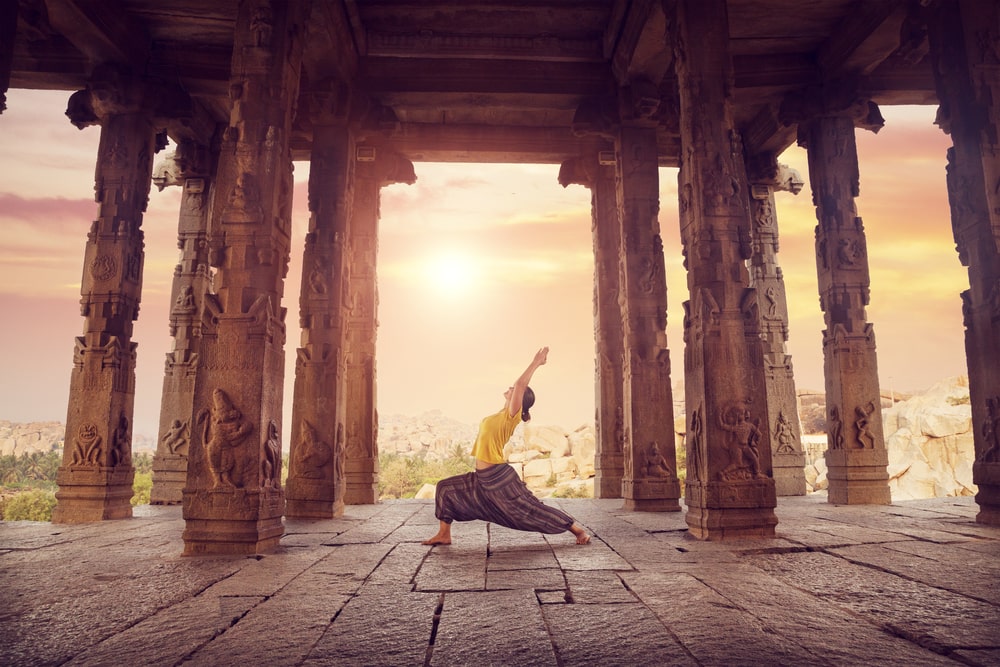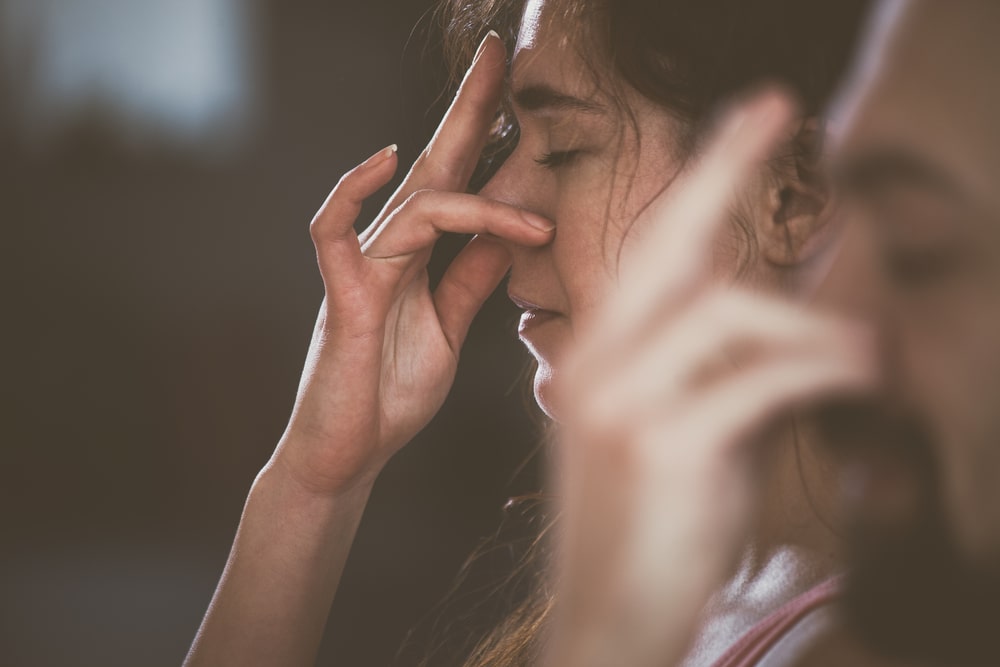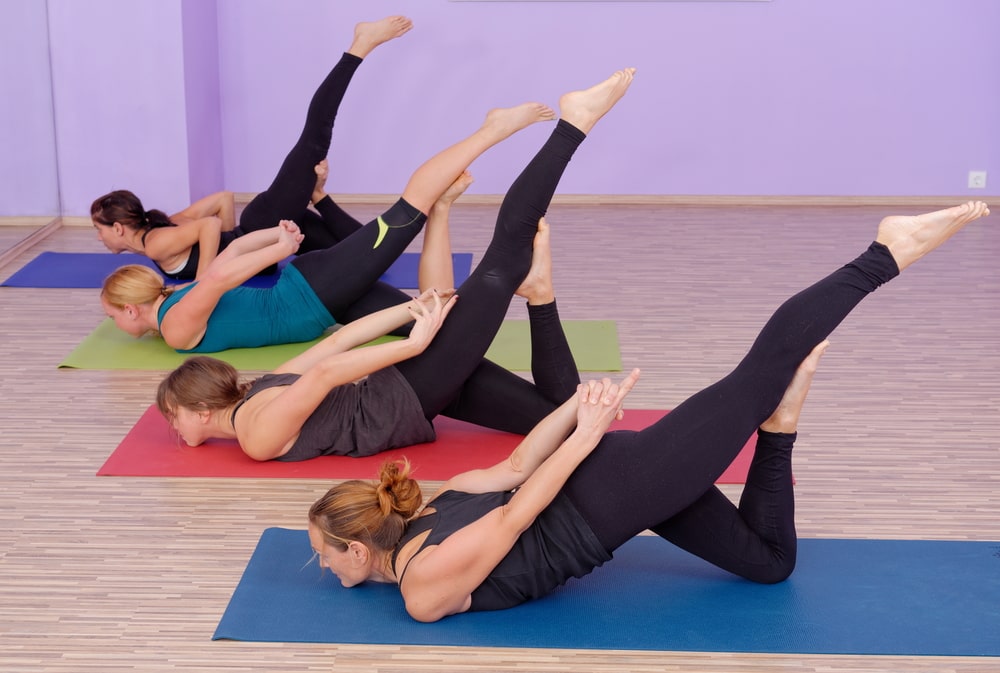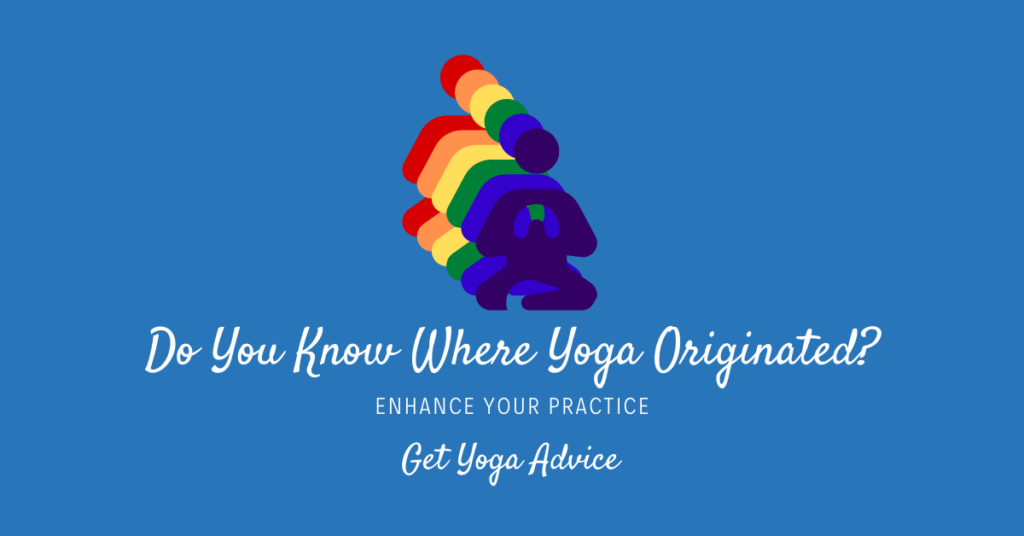Yoga is an ancient and complex practice that began as a spiritual endeavour and later became a way to promote physical and mental well-being. Ancient yoga philosophy and practice originated in India. It has evolved over the years, but many of its original roots are still a part of the modern teachings of yoga.
A yoga practice provides you with physical, mental, and spiritual benefits, and for many people, is the key to living at peace.
Contents
- 1 Yoga History
- 2 Yoga – The Six Periods of Evolution
- 3 Yoga Therapy
- 4 Popular Types of Yoga
- 5 Final Word on Yoga History and Where Yoga Originated
Yoga History

It’s possible to practice yoga and enjoy your practice without knowing its history. However, understanding the history of yoga and knowing more about the ancient yoga tradition enhances your practice.
Nobody is sure exactly when people began practicing yoga. Some believe yoga began 4000 to 8000 years ago. Archaeologists have found evidence that yoga poses were practiced as early as 3000 BC, but most agree that yoga existed before that time.
Others have traced the beginning of yoga to Stone Age Shamanism, when it was practiced to improve the human condition and promote healing. Still some say it began around 500 BC, when Buddhism began.
Originally, yoga focused primarily on community more than inner self development. The word yoga derives from the Sanskrit word “yuj,” which means to unite. It brings together the individual with a higher power.
The classical definition of yoga is to control the modifications of the mind and regardless of what type of yoga you practice, the goal is always to control the mind.
Over the centuries, yoga has undergone a variety of modifications and yogic practice today is different than yoga in its original form. But the aim is still to gain control of and quiet the mind.
To gain a better understanding of yoga, it helps to divide its evolution into six periods.
Yoga – The Six Periods of Evolution
1. Pre-Vedic Period (3000 BC and Earlier)
The Pre-Vedic or Ancient Yoga Period is depicted in recently discovered Mohenjodaro and Harappa excavations. There is no written record of yogic practice from this time, but there are images of people practicing postural yoga.
Many people now agree that the roots of yoga trace back approximately 5000 years.
2. Vedic Period (3000 BC to 800 BC)
We have a better understanding of yoga being practiced during this time. The Vedas – sacred scripture on which modern-day Hinduism is built – came into existence during this period.
The Vedas are a collection of hymns dedicated to a divine power. They are the oldest traditional yoga teachings, and include rituals and ceremonies that seek to surpass the limits of the mind.
The Vedic people turned to yogis or rishis to help them learn to live in divine harmony. They practiced yoga ritually with the aim of transcending the mundane and developing their concentration. Rishis had the ability to see reality through their intense spiritual practice. Many yogis lived in seclusion, seeking understanding and peace of the mind.
The yoga practiced during this time was different than what we see today, but it is possible to see how modern yoga grew from this original effort.
3. Pre-Classical Yoga (800 BC to 250 BC)
Pre-Classical Yoga, also known as Upanishads, brought to practitioners 200 scriptures that describe the inner vision of reality that arises when someone is fully devoted to the Brahman. It focuses on three subjects:
- Ultimate reality
- Transcendental self
- Relationship between the two
The Upanishads further explains the Vedas and gives greater insight into the “why” of yoga rituals from this time.
During this time in the sixth century BC, Buddhism and yoga began to blend. Siddharta Gautama was the first Buddhist to practice yoga. It was at this time that we see the blend of Hinduism and Buddhism become part of yoga history.
Buddhism taught the importance of meditation and the practice of physical postures while meditating.
It was shortly after this that the Bhagavad-Gita or “Lord’s Song” was created. It is the oldest known yoga scripture and in summary states that activity is the essence of life and we must rise above our egos in order to avoid difficulties in life.
In much the same way that the Upanishads furthered the Vedas, the Gita expands Upanishads. It was a conversation that occurred between Prince Arjuna and Krishna, in which the two emphasized the importance of opposing evil.
According to the Gita, there are three facets of our lives that we must bring together. These include:
- Bhakti (loving devotion)
- Jnana (knowledge or contemplation)
- Karma (selfless action)
The Gita unified these three practices.
4. Classical Period (184 BC to 148 BC)
The teachings of yoga continued to expand during the Classical Period. This was the time in which the Yoga Sutras were created. The intention of Patanjali’s sutraswas to organize, define, and standardize Classical Yoga.
Patanjali recorded 195 yoga sutras into a concise form that made it easier to practice. This organization was known as Raja Yoga. Raja Yoga contains eight classical limbs, including:
- Yama (social conduct and ethical values)
- Niyama (personal conduct that includes purity, tolerance, and study)
- Asana (physical postures)
- Pranayama (breathing)
- Prathyahara (withdrawal of senses in preparation for meditation)
- Dharana (concentration)
- Dhyana (meditation)
- Samadhi (transcendence or ecstasy)
According to Patanjali, every person is composed of matter and spirit. He believed the two must be separated to cleanse the spirit, which was in opposition to the beliefs taught in Vedic and Pre-Classical yoga that called for a unionizing of the body and spirit.
Over time, some yogis moved their focus to primarily meditation and neglected the body. Eventually, the belief of the body as a temple came back into favor and the goal of yoga was to change the body to create immortality.
What is an Asana?
An asana is a body posture. It originally described the meditation pose in early yoga before movement became such an integral part of a yoga practice. Asana describes any type of pose or position, including reclining, standing, inverted, twisting, and balancing poses.
What is Pranayama?

Pranayama is the practice of controlling one’s breath during yoga. Modern practitioners use pranayama to synchronize their breath between asanas. Pranayama also describes the exercise of breathing following the completion of asanas.
5. Post-Classical Period (800 AD to 1700 AD)
Yogis of this period placed great importance on the asanas, kriyas, and pranayama. The intention was to cleanse the mind and the body. Today, this is known as hatha yoga, which helps practitioners reach higher levels of practice. Practitioners no longer sought to free themselves from reality, but instead, to accept it and live in the present.
6. Modern period (1863 AD to Present Day)
It was shortly after this period that yogic philosophy was introduced to the west. At first, it was studied as an Eastern Philosophy. It was popular throughout the 1930s and was part of the health movement.
By mid-century there were many teachers of yoga in the west. Swami Vivekananda introduced yoga to much of the world during a speech at the Parliament of Religions in Chicago.
Another, Mahaishi Mahesh, popularized Transcendental Meditation. And yet another popular yoga teacher during this time was Swami Sivananda, a Malaysian doctor who opened yoga schools throughout Europe and the United States. Sivananda’s work modified yoga into five principles that included:
- Savasana (relaxation)
- Asanas (exercise)
- Pranayama (breathing)
- Proper diet
- Dhyana (meditation)
Sivananda authored over 200 books on yoga and philosophy. He had many students who carried on his teachings. One of his students brought yoga and teaching to Woodstock and another studied the connection between yoga and psychology. Another began teaching Kundalini yoga in the 1970s.
Yoga Therapy
All yoga is therapeutic, but yoga therapy is the specific application of yoga to provide relief from physical, emotional, or mental pain. Yoga therapists are trained to apply yoga in a manner that helps their clients safely and effectively and to meet specific therapy goals. Yoga therapy includes:
- Movement
- Breathing
- Meditation
- Physical postures that address specific imbalances or discomfort
- Combination of any of the above
Yoga therapy is personalized and a particular session is based on the individual health and well-being of the client. Many people mistakenly believe that yoga is about stretching or physical movement only, but yoga therapy is holistic and helps with all aspects of health, from physical to mental to spiritual well-being.
Popular Types of Yoga
1. Hatha Yoga and Vinyasa Yoga
Vinyasa and Hatha yoga are two of the most popular forms of yoga in practice today. Both types of yoga improve well-being and are relatively good for beginners. However, Vinyasa yoga tends to move quickly through asanas, whereas Hatha yoga is slower and focuses on proper alignment.
Most yoga teachers recommend beginning with Hatha yoga and moving onto Vinyasa once students are comfortable with poses and doing them correctly.
Both Vinyasa and Hatha yoga provide a variety of benefits, including:
- Reducing anxiety
- Improving balance
- Boosting physical fitness
- Easing pain
- Lowering blood pressure
- Easing menopausal symptoms
- Improving mental health
- Easing chronic pain and diseases
- Improving endurance
- Weight loss
These benefits are backed up by medical science, too. A 2016 analysis of 17 different studies that included more than 500 people showed Hatha yoga to be an effective treatment for anxiety. A 2014 study showed that five months of Hatha yoga practice led to better posture and balance.
Vinyasa yoga strengthens the immune system, increases strength, promotes better sleep, and helps increase lung capacity.
Many of the benefits of Hatha yoga and Vinyasa overlap. It’s possible to practice both of these types of yoga and many people incorporate both into their routines. Hatha yoga is a slower, more soothing practice, while Vinyasa tends to be more of a demanding workout.
Determining which type is right for you is based purely on personal preference and your needs on any given day.
2. Bikram Yoga

Bikram yoga, sometimes called hot yoga, is a yoga practice that involves a sequence of poses performed in a room with a temperature of approximately 105 degrees Fahrenheit and about 40 percent humidity. It became popular in the 1970s in California, and classes can now be found throughout the United States.
During Bikram yoga, practitioners repeat 26 poses in a cycle that lasts for 90 minutes. The poses are based on classic hatha poses with the intention of moving fresh, oxygenated blood throughout the entire body.
Poses include tree pose, eagle pose, triangle pose, cobra pose, and more. Traditionally, Bikram yoga included no inverted poses, though some teachers today have incorporated more difficult poses.
3. Tantric Yoga
Tantra comes from two Sanskit words. Tan, meaning “to spread or expand” and tra, meaning instrument. Tantra is an instrument of expanding the level of consciousness.
The philosophical practice of Tantra is the belief that “nothing exists that isn’t divine.” It’s a practical system of yoga and it’s based on the experiences of Tantric sages.
This dynamic system has evolved over time and though it’s often associated with sex, sexual intimacy is only a part of Tantric practice. As a matter of fact, the majority of Tantric teachings have nothing to do with sexuality.
Tantric practitioners do use sex to move beyond the mind and into higher states of consciousness. But sex is merely a path to spiritual growth – a means to an end, as opposed to the core of the practice.
Tantric practitioners adhere to certain rules and practices throughout all aspects of their lives with the belief that they will achieve love, happiness, and ecstasy when they apply the rules properly.
Final Word on Yoga History and Where Yoga Originated
Modern day yoga doesn’t look exactly like yoga in its original form as it was practiced in the Eastern world. Nevertheless today’s practice is based on much of the same teachings that have existed since yoga began.
One of the primary differences is that modern yoga focuses on working on the body before beginning the work on the mind. Yoga often begins as a fitness class for someone, but then they can move on to embrace the other aspects of yoga and incorporate it into daily life.
You can begin yoga for the physical benefits and as you learn more and dive deeper into their practice, you can begin to see the mental and spiritual benefits as well.



